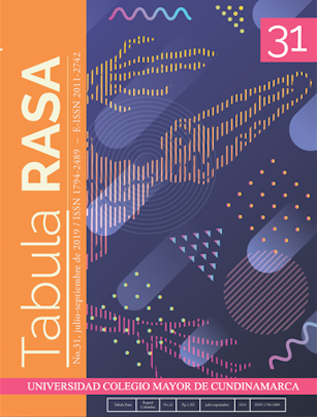“De muitas lutas”: vacas, cowboys e o processo de produção de carne no sul dos Estados Unidos
Mostrar biografia dos autores
Neste texto, ratreio alguns encontros que ocorrem ao longo de um processo de produção de carne bovina de qualidade suprema, ao sul dos Estados Unidos. Ao atender aos encontros materiais, discursivos e afetivos na medida em que estes produzem corpos, o texto oferece um olhar sobre a produção pecuária que passa a ser considerada muito mais que uma sequência de práticas voltadas para a produção de carne, sendo vislumbrada como um acúmulo de contatos, fricções e rupturas. Nesse sentido, propõe-se uma série de reflexões sobre as formas pelas quais a vida e a morte animal são constituídas mediante os processos de produção contemporâneos.
Visualizações de artigos 258 | Visitas em PDF 85
Downloads
- Alaimo, S. (2013). Sexual matters: Darwinian feminisms and the nonhuman turn. J19: The Journal of Nineteenth-Century Americanists, 1(2), 390–396.
- Blanchette, A. (2018). Industrial Meat Production. Annual Review of Anthropology, 47(1), 185–199. https://doi.org/10.1146/annurev-anthro-102317-050206
- Clark, J. L. (2012). Ecological Biopower, Environmental Violence Against Animals, and the “Greening” of the Factory Farm. Journal for Critical Animal Studies, 10(4), 109–129.
- Coppin, D. (2003). Foucauldian Hog Futures: fte Birth of Mega-Hog Farms. The Sociological Quarterly, 44(4), 597–616.
- Dias, L. S., Hadlich, J. C., Luzia, D. M. M., & Jorge, N. (2016). Influence of breed on beef and intramuscular fat quality from nellore (Bos indicus) and wagyu (Bos taurus) crossbreed cattle. International Food Research Journal; Selangor, 23(4), 1523–1530.
- Drouillard, J. S. (2018). Current situation and future trends for beef production in the United States of America—A review. Asian-Australasian Journal of Animal Sciences, 31(7), 1007.
- Galvin, S. S. (2018). Interspecies Relations and Agrarian Worlds. Annual Review of Anthropology, 47(1), 233–249.
- Greene, C., Ferreira, G., Carlson, A., Cooke, B., & Hitaj, C. (2017). Growing organic demand provides high-value opportunities for many types of producers. USDA Recuperado de: https://www.ers.usda.gov/amber-waves/2017/januaryfebruary/growing-organic-demand-provides-high-value-opportunities-for-many-types-of-producers/
- Haraway, D. J. (2007). When Species Meet. Minneapolis: University Of Minnesota Press.
- Haraway, D. J. (2016). Staying with the Trouble: Making Kin in the Chthulucene. Durham: Duke University Press.
- Hayes, D., & Hayes, G. B. (2015). Cowed: The Hidden Impact of 93 Million Cows on America’s Health, Economy, Politics, Culture, and Environment. New York: W. W. Norton & Company.
- Heidegger, M. (1927). Being and Time. New York: Harper Perennial Modern Classics.
- Holt, R., Hernes, T., Helin, J., & Hjorth, D. (2016). Process is how process does. En J. Helin, T. Hernes, D. Hjorth, & R. Holt (Eds.), The Oxford Handbook of Process Philosophy and Organization Studies (pp. 1–16). Oxford: Oxford University Press.
- Imhoff, D. (Ed.). (2010). The CAFO Reader: The Tragedy of Industrial Animal Factories. Healdsburg, Calif. : Berkeley: Watershed Media.
- Jackson, J. (2006). Los Mesteños: Spanish Ranching in Texas, 1721-1821. Texas: Texas A&M University Press.
- Jarvis, B. F., & Song, X. (2017). Rising Intragenerational Occupational Mobility in the United States, 1969 to 2011. American Sociological Review, 82(3), 568–599.
- Jordan, T. G. (1981). Trails to Texas: Southern Roots of Western Cattle Ranching. Lincoln: University of Nebraska Press.
- Jordan-Bychkov, T. G., & Jordan, T. G. (1993). North American Cattle-Ranching Frontiers: Origins, Diffusion and Differentiation. Albuquerque: University of New Mexico Press.
- Kirby, D. (2011). Animal Factory: The Looming Threat of Industrial Pig, Dairy, and Poultry Farms to Humans and the Environment. New York: St. Martin’s Griffin.
- Kohn, E. (2007). How dogs dream: Amazonian natures and the politics of transspecies engagement. American Ethnologist, 34(1), 3–24.
- Law, J. (2004). After Method: Mess in Social Science Research (1 edition). London ; New York: Routledge.
- Lemke, T., Casper, M. J., & Moore, L. J. (2011). Biopolitics: An Advanced Introduction. New York: NYU Press.
- Niman, N. H. (2014). Defending Beef: The Case for Sustainable Meat Production. White River Junction, Vermont: Chelsea Green Publishing.
- Ogle, M. (2013). In Meat We Trust: An Unexpected History of Carnivore America. Boston: Houghton Mifflin Harcourt.
- Pace, R. F., & Frazier, D. D. S. (2012). Frontier Texas: History of a Borderland to 1880. Texas: State House Press.
- Ribas, V. (2015). On the Line: Slaughterhouse Lives and the Making of the New South. Oakland: University of California Press.
- Schwartz, J. D., & Ehrlich, G. (2013). Cows Save the Planet: And Other Improbable Ways of Restoring Soil to Heal the Earth. (L. Jorstad, Ed.). White River Junction: Chelsea Green Publishing.
- Specht, J. (2019). Red Meat Republic: A Hoof-to-Table History of How Beef Changed America. Princeton, Princeton University Press.
- Stewart, K. (2017). In the World that Affect Proposed. Cultural Anthropology, 32(2), 192–198.
- Striffler, S. (2007). Chicken: The Dangerous Transformation of America’s Favorite Food. New Haven: Yale University Press. ftompson, E. P. (1967). Time, Work-Discipline, and Industrial Capitalism. Past & Present, (38), 56–97.
- Tsing, A. L. (2015). The Mushroom at the End of the World: On the Possibility of Life in Capitalist Ruins. Princeton: Princeton University Press.
- USDA. (2014). 2012 Census of Agriculture. Summary and State Data. Washington, D.C.: U.S. Department of Agriculture’s National Agricultural Statistics Service.
- USDA. (2016). 2012 Census of Agriculture. Organic Survey (20 14 ). Washington, D.C.: U.S. Department of Agriculture’s National Agricultural Statistics Service.








